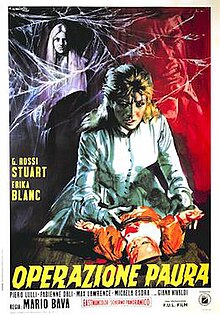| Kill, Baby, Kill | |
|---|---|
 Italian film poster by Averardo Ciriello[1] | |
| Italian | Operazione paura |
| Directed by | Mario Bava |
| Screenplay by |
|
| Story by |
|
| Produced by |
|
| Starring | |
| Cinematography | Antonio Rinaldi[2] |
| Edited by | Romana Fortini[2] |
| Music by | Carlo Rustichelli |
| Color process | Eastmancolor |
Production company | F.U.L. Films |
| Distributed by | Internazionale Nembo Distribuzione Importazione Esportazione Film |
Release date |
|
Running time | 83 minutes[2] |
| Country | Italy |
| Language | Italian |
| Box office | ₤201 million |
Kill, Baby, Kill (Italian: Operazione paura, lit. 'Operation Fear')[3] is a 1966 Italian gothic horror film directed by Mario Bava and starring Giacomo Rossi Stuart and Erika Blanc. Written by Bava, Romano Migliorini, and Roberto Natale, the film focuses on a small Carpathian village in the early 1900s that is being terrorized by the ghost of a murderous young girl.
Overseen by one-time producers Nando Pisani and Luciano Catenacci of F.U.L. Films, Kill, Baby, Kill was considered to be a small-scale project compared to Bava's earlier films, as it was made without internationally recognized stars or the support of a major distributor. Although a complete script was written by Migliorini and Natale prior to the start of production, Bava claimed that much of the film was improvised. Shot partially on location in Calcata, Faleria and at the Villa Grazioli in 1965, the film underwent a troubled production due to F.U.L. Films running out of money during principal photography, prompting the cast and crew to finish the film in the knowledge that they would not be paid for their work. In post-production, the score had to be compiled from stock music created for earlier film productions.
Although the film's commercial performance during its initial Italian theatrical release was limited, its domestic run outgrossed those of Bava's previous horror films; abroad, it garnered positive notices from Variety and the Monthly Film Bulletin. With the re-evaluation of Bava's filmography, Kill, Baby, Kill has been acclaimed by filmmakers and critics as one of the director's finest achievements; it was placed at number 73 on a Time Out poll of the best horror films.[4]
- ^ Curti 2015, p. 160.
- ^ a b c d Curti 2015, p. 159.
- ^ Brunetta 2009, p. 201.
- ^ "Best Horror Movies - 100 Scary Movies To Watch Now, Ranked By Experts". Timeout.com. Retrieved 25 April 2022.